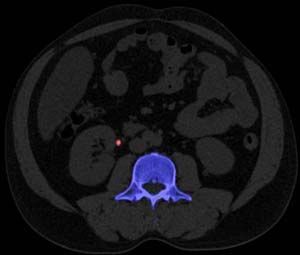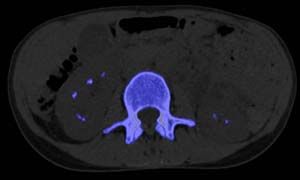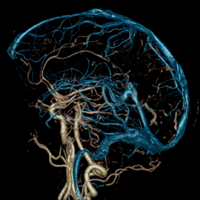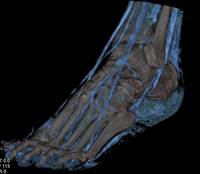Dual-energy CT edges toward clinical implementation and wider acceptance
Slice wars have long dominated advances in CT technology. That situation is changing, and the market appears ripe for innovation. Energy-dependent imaging, a topic first aired over two decades ago, is back on the agenda
Slice wars have long dominated advances in CT technology. That situation is changing, and the market appears ripe for innovation. Energy-dependent imaging, a topic first aired over two decades ago, is back on the agenda.
The reasons why two energies can be better than one will be explained this afternoon. Speakers at the special focus session on dual-energy CT will outline the rationale behind this strategy, the different ways of gathering multi-energy CT data, and the potential clinical benefits.

But is this an idea for tomorrow or today? After all, attempts to move energy-dependent imaging into the mainstream 20 years ago were unsuccessful. A panel discussion at the end of the session will reveal the presenters' views, based on their personal experiences.
"It is rather like a technological revival," said Dr. Hatem Alkadhi, head of body CT at the Institute of Diagnostic Radiology, University Hospital Zurich, in Switzerland. "The technique is so technically advanced now that it is feasible and practical to apply it to routine clinical radiology."

The principle behind dual-energy CT is relatively straightforward. Spectral information gathered from x-ray photons depends to a certain extent on the photons' energy. No attempt is made to separate out these subtle energy-dependent differences in conventional CT studies. In comparison, dual-energy CT techniques deliberately extract and compare data from photons in two distinct energy bands. This information can then be used to distinguish between structures that have different material compositions but similar CT attenuation profiles.
The earliest attempts to gather information at different energy levels required patients to be scanned twice with a single-slice CT unit. Results were limited by the low photon output at low energy levels and by problems coregistering the separate images. Technology has since moved on. A dual-source CT system that has two separate x-ray tubes and corresponding detector elements is available commercially from Siemens, and alternative ways of acquiring dual-energy CT images, including multilayer detectors, are being explored by other vendors.
One advantage of dual-energy CT is its ability to remove bone from data sets. This application is especially helpful for vessel imaging studies where radiologists and vascular surgeons prefer to look at 3D views. Bony structures can obscure the vascular anatomy on these reconstructions, making it difficult to establish an accurate diagnosis or use the images for treatment planning.




Software packages designed to subtract the bone can sometimes remove parts of vessels, said Dr. Thorsten Johnson, a radiologist at the University Hospital of Munich-Grosshadern in Germany. Chunks of bone may be left on the image as well. As a consequence, radiologists have to go through the data set manually and correct mistakes made by the software.
"For runoff CT angiography studies, it can take seven or eight minutes to get a preloaded data set into a condition where it is fully diagnostic. With dual-energy CT, there is some time required for the calculations, but that is all carried out without any input from the user," he said.
Easy removal of iodinated contrast from images is another key feature of dual-source CT. This technique means that patients scheduled for two CT scans (one with contrast and one without) need only have one. The precontrast scan is replaced by a virtual unenhanced CT study.
This approach is particularly useful when imaging patients with flank pain who may have kidney stones, said Dr. Paul Stolzmann, a radiologist at the Institute of Diagnostic Radiology, University Hospital Zurich. The stones often cannot be seen from contrast-enhanced CT alone.
"This might be the most striking application of dual-energy CT," he said. "You can just administer the contrast and then detect these stones from one acquisition, saving radiation dose to the patient."
Data from dual-energy CT can also characterize these masses, showing which contain uric acid and which do not. This information will influence whether the patient receives medical or surgical treatment.
Some radiologists still wrongly believe that moving to dual-energy CT means doubling the dose, according to Johnson. His experience suggests that this assumption is not justified. Radiologists at his hospital have adapted the tube currents on their dual-source CT system so the dose index of all CTA protocols performed on this machine will be the same as when the studies were done on a 64-slice system.
As with all new technologies, initial implementation of dual-energy CT revealed a few limitations, Johnson said. For example, the small size of the second detector meant that the periphery of the lung could not be included on images. There was also room for improvement in the signal-to-noise ratio. These issues have both been addressed in the latest version of the system, showcased at the RSNA meeting in Chicago in December 2008 and due to be installed at the Grosshadern campus in the near future.
"These minor drawbacks are outweighed by the benefits we gain from the additional dual-energy information," he said. "And with the new system that is coming, we will not have these drawbacks any more. So yes, I would say that dual-energy CT is ready for clinical implementation."
GE HealthCare Debuts AI-Powered Cardiac CT Device at ACC Conference
April 1st 2025Featuring enhanced low-dose image quality with motion-free images, the Revolution Vibe CT system reportedly facilitates improved diagnostic clarity for patients with conditions ranging from in-stent restenosis to atrial fibrillation.
The Reading Room: Racial and Ethnic Minorities, Cancer Screenings, and COVID-19
November 3rd 2020In this podcast episode, Dr. Shalom Kalnicki, from Montefiore and Albert Einstein College of Medicine, discusses the disparities minority patients face with cancer screenings and what can be done to increase access during the pandemic.
Can Photon-Counting CT be an Alternative to MRI for Assessing Liver Fat Fraction?
March 21st 2025Photon-counting CT fat fraction evaluation offered a maximum sensitivity of 81 percent for detecting steatosis and had a 91 percent ICC agreement with MRI proton density fat fraction assessment, according to new prospective research.